
Renewable energies
Renewable energies are not withdrawn from an exhaustible (geological) stock. Instead, they are supplied by such sources, which last almost for ever and which are available for the planet earth in a continuous way. All such sources of renewable energy can be traced back to three phenomena, which originate from different physical processes. These are with increasing importance:
The gravitational fields of earth and moon are responsible for the tides and partially also for the formation of water waves. From both natural processes (tides, waves) a conversion into useful energy can be realised. The fluid hot core region of the earth is permanently heated by radioactive decay processes. This is the source for the world-wide averaged subsoil geothermal temperature gradient of about 3°C per 100 m depth. For sufficiently large distances below the earth´s surface the temperature there is high enough to exploit geothermal energy. Nuclear fusion within the sun, finally, is responsible for the emission of electromagnetic radiation from the sun´s surface, which is captured by the earth and creates there an (in time and location) averaged energy flux of 226 W/m². Water, wind, waves, ambient heat near the earth´s surface, biomass and more are secondary effects of the sun´s radiation and offer many opportunities to use solar energy in an indirect way. Direct utilization of the sun´s energy names the immediate use of solar radiation e.g. by solar thermal collectors, photovoltaic modules or by solar chemical processes like photolysis.
This means: gravitation, radioactive decay and nuclear fusion - all of them in far distance from the human biosphere - are sources of renewable energy on the earth and provide almost inexhaustible primary energy. By many kinds of subsequent technical processes this energy can be converted into secondary energy sources or even final energy, respectively, like heat, electricity or fuel. Figure 1 presents a detailed scheme for the multitude of possibilities.
 |
| Figure 1: General scheme of renewable energies and related conversion processes (Source: Fachhochschule Aachen, Germany). |
In contrast to energies from exhaustible fossil or nuclear fuels, renewable energies are well suited for a sustainable economics. The physical/technical potential of their availability is by far larger than that what is presently needed word-wide. Additionally, renewable energies help to protect environment and climate. The technical feasibility to operate systems with renewable energies has been largely demonstrated. Therefore, the currently still small and reluctant use of renewable energies is not due to insufficient technology, but predominantly due to better economic conditions for systems with conventional energy supply (fossil, nuclear).
Subsequent discussions focus on the utilization of solar energy, which provides the by far most promising and versatile potential of applications. Its impressive quantity becomes evident when comparing the annual solar energy incident on earth (about 3.64·106 EJ) with the annual world-wide consumption of primary energy (about 400 EJ). This is more than 9.000 times of that energy which is needed. In other words: The actual (not very efficient) energy system of the whole world could be based on renewable energy by using only about 0.01% of the annually incident solar energy. Anyway, in the long term, such a substitution is inavoidable, as can be learned from Figure 2.
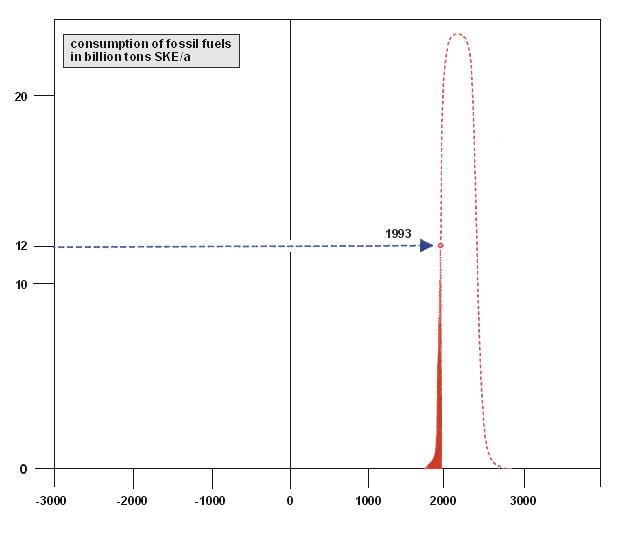 |
| Figure 2: Historical and expected future temporal course of fossil fuel consumption. |
Figure 2 displays the world´s annual consumption of primary energy for a time scale of historical length. This scale starts at 4000 BC (before Christ) and ends at 4000 AD (Anno Domini). For the period between 4000 BC until 1850 AD there was almost no consumption of primary energy from the geological stock. After 1850 until today, a very steep increase of the annual consumption of primary energy takes place (black coloured area within the diagram). All corresponding analyses and scenarios indicate that this increase of energy consumption will continue during the foreseeable future. As the area below the curve of consumptions represents the total amount of (fossil, nuclear) energy resources - which must be finite - the curve of consumptions has to come down again and will fall to zero at any point in time. One can imagine, that during this last period with increasing demand and decreasing reserves the energy costs will rise rapidly. Nobody knows exactly, at what time (2100, 2200, 2300) the era of exploitation of the fossil/nuclear energy stock will definitely end. Nevertheless, one has to conclude that mankind will have plundered within 250 years to 500 years all fossil stocks (= stored solar energy) which had been piled up during the last 350 million years. This means, that the era of utilization of fossil/nuclear fuels will be only a very short and singular episode within the history of mankind. Many more thousand years before that episode, well developed human cultures did exist which were based on renewable energies only. And also after that episode the mankind will have to master its future with sustainable (not exhausting) technologies.
The use of solar energy happens either directly - by immediate utilization of solar radiation - or in an indirect way - by using other sources of energy (like running water, biomass, wind and ambient energy), which are only depending on solar energy. The use of solar energy is called "active", if it needs special apparatus or equipment for harnessing the solar energy. It is called "passive", when it is realized mainly by measures of building design and construction. This chapter focusses on active and direct use of solar energy.
A basic item is solar radiation on the earth´s surface. Depending on climate, the solar radiation has different durations. For northern Europe they vary between 700 h and 800 h per year, and reach values of 1.400 h up to 1.800 h per year for mid-Europe, with the larger numbers increasing direction towards south. It is worth to know, that even in the arid desert areas near the equator, 2.400 h of sunshine are never exceeded.
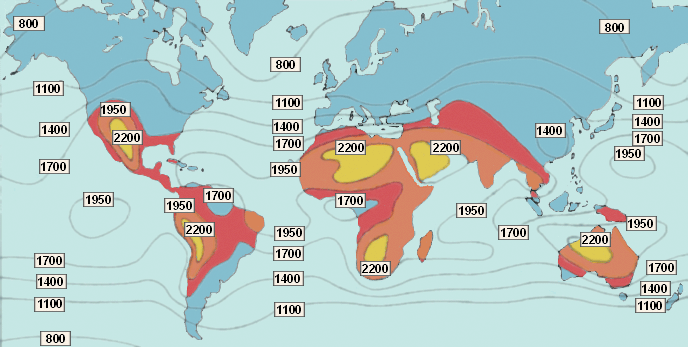 |
| Figure 3: Geographical distribution of annual mean sunshine hours [2]. |
For the utilization of solar energy not only its duration, but also its type and quantity are determining. Important are global, diffuse and beam (direct) radiation onto horizontal or arbitrarily inclined surfaces (Figure 4). Global radiation is the sum of beam (direct) and diffuse radiation. The separation of global radiation into beam radiation (coming directly from the sun) and diffuse radiation (coming from the remaining hemisphere) is important for two reasons: Firstly, these distinguished parts must be known for the conversion of global radiation, incident onto a horizontal plane, into that which falls onto an arbitrarily inclined area. Secondly, it is relevant for the decisions about the technical and economical feasibility of systems with concentrating collectors. Nowadays many databases and tools exist on a commercial basis (Radiation atlas for the EU, METEOSAT data, METEONORM, TRNSYS [1, 2, 3, 4], to name a few) which provide a planner with radiation data for a wealth of stations and which are well suited for radiation processing.
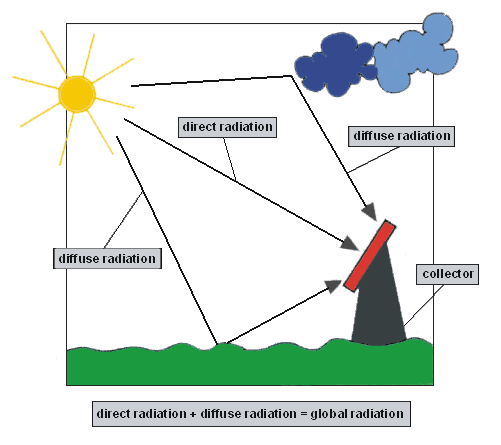 |
| Figure 4: Illustrations of global, direct and diffuse radiation. |
Already today many methods exist to use solar energy. This is not too early, because world-wide efforts for the protection of climate require a firm and rapid change of energy technology towards renewable energies already by now. The spectrum of available techniques is very wide (see Figure 1). It includes:
Within the context of "energy-efficient building" and for climates where heating is required at least during some months of a year, the description of applicable and successful solar systems can be focussed on three topics:
Thereby, two basic inventions of solar technology are employed: the solar thermal flat plate collector and the photovoltaic cell. Both components are using direct as well as diffuse solar radiation (= global radiation).
Figure 5 illustrates the principle of a solar thermal collector. It converts solar radiation into useful thermal energy (heat). This takes place within a heat exchanger, where the heat which is generated by absorbed solar radiation is first transferred to a suitable fluid (mostly water with additives) and then supplied to the user. To reduce heat losses, the back face and side frames of the collector are thermally insulated. The solar aperture is covered by one or two gass panes, also in order to optimize heat losses at the sun-facing side. High performance collectors are equipped with specially coated absorber plates which significantly suppress infrared back radiation. Thermal efficiencies of collectors depend - besides on its construction - additionally very much on meteorological boundary conditions (global radiation, ambient temperature) as well as on the operational characteristics of the user system (temperatures of storage tank and back flow). For southern Germany, well designed systems gain annually up to about 450 kWh of useful heat per m² collector area.
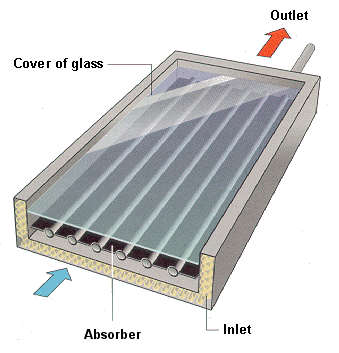 |
| Figure 5: Scheme of a solar thermal flat plate collector [1]. |
Figure 6 shows the principle of a photovoltaic cell (PV-cell, solar cell). It directly converts solar radiation into electricity. From suitable light the inner photoelectric effect generates an electric current. For that, one needs the interface between two differently doped (with electrons or holes) lattices of a semiconductor. The most common semiconductor used is silicon with mono- or polycrystalline structure or even as amorphous material. Best efficiencies are obtained with monocrystalline silicon (up to about 16%). Polycrystalline silicon reaches about 12% and with amorphous silicon about 8% can be achieved. The n-doped (e.g. by atoms of the 5th column of the periodic system of elements) silicon is facing to the sun; the p-doped (by atoms of the 3rd column) silicon is situated at the dark side. Both layers are connected with a consumer, which is run through by an electric current if solar radiation is available. Such solar cells are combined in serial and/or in parallel groups and then assembled as PV-modules, which deliver the electric power in the form of DC under well defined voltage conditions. For Germany (annual global radiation onto a horizontal plane: about 1,000 kWh/m² ± 15%), a photovoltaic plant which is designed for 1 kWpeak yields under best circumstances about 800 kWh of useful electric energy. This corresponds for polycrystalline modules to an area of 8 m² to 10 m².
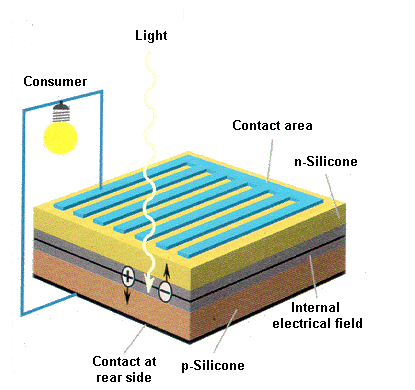 |
| Figure 6: Scheme of a photovoltaic cell [1]. |
For the supply with domestic warm water solar thermal collectors (round 1.5 m² per person) have to be mounted with suitable tilt angle and oriented towards south mostly on roofs. They feed a hot water tank which is - whenever needed - backed up by an electric or gas operated heater (see chapter Domestic hot water). By this way about 50% to 60% of the total load are contributed by solar energy.
For solar assisted room heating see chapter Heating systems. There will be discussed how the fluid is heated by solar thermal collectors and can be fed into the heating circuit. An alternative method to assist room heating by solar energy is a heat pump, which uses the ambient energy as heat source. Again, more details are mentioned in chapter Heating systems.
Figure 7 displays how the electric energy gained by the PV-modules (they also are mostly installed on south-facing tilted roofs) can be integrated into the electric supply system of a house. In this figure a system with grid coupling is considered. A DC/AC converter adapts the direct electric current coming from the PV-modules to common alternating electric current as it is used in households. By this, the electric currents from PV-modules and from the grid become useable in the same way. With two electricity meters the electricity currents which are withdrawn from and feeded into the grid are distinguished and metered separately.
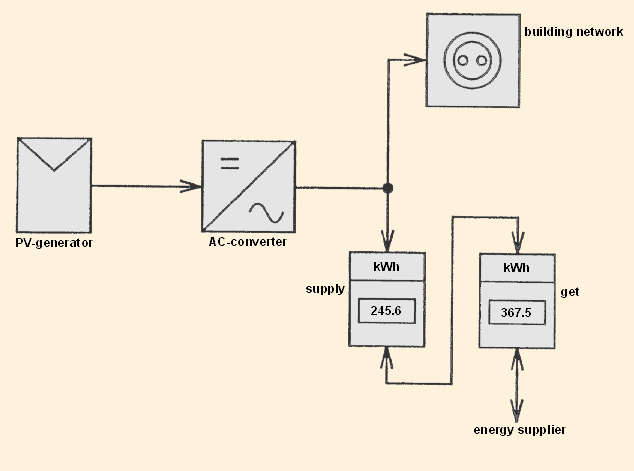 |
| Figure 7: Block diagram of a grid connected PV-system for houses. |
Literature / Links:
[1] Bundesministerium für Wirtschaft - "Erneuerbare Energien verstärkt nutzen!", Herausgegeben vom Bundesministerium für Wirtschaft, Referat Öffentlichkeitsarbeit, D-53107 Bonn, 2. Auflage, Oktober 1994.
[2] M. Kleemann, M. Meliß - "Regenerative Energiequellen", Springer Verlag, 2. Auflage, 1993.
[3] W. Roth, H. Schmidt - "Photovoltaik-Anlagen", Herausgeber: Frauenhofer-Institut für Solare Energiesysteme, Freiburg, Koor-Comett-Best-Verlag, 1994.